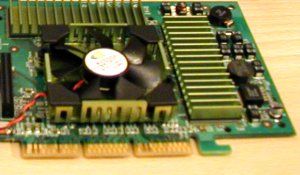Elsa Gladiac Ultra: A Perfect Graphics Card?
Features Of NVIDIA's GeForce 2 Ultra
The only difference between the 3D-chips of the GeForce 2 GTS and the GeForce 2 Ultra is the fact that the latter runs at a faster clock speed. While the GTS chip is clocked at 200 MHz, its brother runs 50 MHz faster. Both have identical 3D feature support, including T&L and are manufactured in 0.18 µm process.
Thanks to faster memory chips, the second and most important difference between GTS and Ultra, the DDR memory, is clocked at 460 MHz (230 MHz DDR) in case of the GF2 Ultra boards. GTS boards usually come with 333 MHz DDR-SDRAM (166 MHz actual clock rate), while the later GeForce 2 Pro cards are running the memory at 400 MHz (200 MHz actual clock).
4 Ns DDR Memory - Expensive, But Powerful
Due to DDR SDRAM chips with a cycle time of only 4 ns, boards with the GeForce 2 Ultra are not only the fastest (1 Gpixel/s and 2 MTexel/s), but also the most expensive graphics solution for comsumers.

At 230 MHz memory clock (460 MHZ DDR) it's now time for some memory coolers.
In the past, a large amount of graphics memory used to be required to enable high resolutions and high color depths for 2D only. Since 3D-capabilities were added to the graphic chips, it turned out that size is not the only thing that matters, adequate bus and memory bandwidth are just as important for 3D performance. Former 3D chip generations weren't able to provide fast frame rates at high resolutions, because not only the fill rate, but also the high memory bandwidth requirements weren't met.
NVIDIA's GeForce 2 was the first available graphics chip architecture which is actually able to run most 3D applications at beyond 1024x768 at satisfactory frame rates. Both high fill rate and memory bandwidth allowed pushing the 3D screen resolution to new heights.
The GeForce 2 Ultra is no miracle, but simply the next step beyond GeForce 2 GTS. Ultra cards are already considerably faster than standard GeForce 2 GTS models because of the increased memory clock. The higher GPU-clock however ensures a further performance boost of those cards.
Stay on the Cutting Edge
Join the experts who read Tom's Hardware for the inside track on enthusiast PC tech news — and have for over 25 years. We'll send breaking news and in-depth reviews of CPUs, GPUs, AI, maker hardware and more straight to your inbox.
One more reason for a 64 MB board is Full Screen Anti Aliasing (FSAA). Back in April, Tom already explained FSAA in detail . Even though you only run the lower resolutions (usually 1024x768 max), the scene is internally rendered at much higher resolutions and then super-sampled down, to reduce the stair step appearance ('jaggies') of objects. With FSAA, the 3D chip calculates values to slightly blur such lines and edges. To do this, the chip needs high fill rates and the memory has to be fast enough to handle high data load. The size of the initially rendered scene plus the final super-sampled frame need to fit into the local graphics memory, which is why the requirements for the amount of graphics memory are much higher in FSAA than for normally rendered scenes.
Current page: Features Of NVIDIA's GeForce 2 Ultra
Prev Page A Barely Affordable Gamer's Dream Solution Next Page Other Boards Using The GeForce 2 UltraMost Popular

